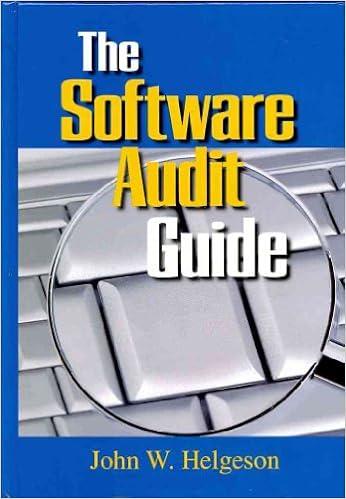Question
BOR CPAs, Inc. is a closely held corporation owned by three stockholders who used the initials of their last names to form the corporations name:
BOR CPAs, Inc. is a closely held corporation owned by three stockholders who used the initials of their last names to form the corporations name: Cyrus Bailey, John Ogden, and Samuel Rogers. The firms Certified Public Accountants (CPAs) perform audits of both public companies and privately owned companies. BORs CPAs also provide tax services to both individuals and businesses.
The corporation is divided into two profit centers: the Audit Division and the Tax Division. Each division is composed of two cost centers. The Audit Division is composed of two cost-center departments: Public Company Audits and Private Company Audits. The Tax Division is composed of two cost-center departments also: Individual Tax and Business Tax.
BOR, a decentralized organization, is interested in evaluating the performance of the two divisions. The stockholders are responsible for deciding on investment in the two divisions. Cyrus Bailey is in charge of the performance evaluation, and turns to you for assistance. Mr. Bailey is only interested in evaluating operations at the profit center (division) level, and not at the cost center (department) level.
Mr. Bailey is considering temporarily using some of the staff from the Tax Division to assist the Audit Division during the upcoming busy audit season, and would like to evaluate the effect of this on net income. The Tax Division is estimated to have 800 hours of excess capacity.
The unit for determining sales revenue in both divisions is the "engagement", which means the total agreed-upon work for a given client in either audit or tax for a given year. The company charges on average a fee of $75,000 per audit engagement, and $15,750 per tax engagement.
The company has its own Payroll Office, which provides payroll services to both divisions and will allocate its total expenses to the two divisions as service department charges.
The following chart shows some basic data for the company:
| Hourly market rate for staff (the price the company would have to pay from an outside contractor for staff services) | $110.00 |
| Average hourly cost rate for staff (the average price the company pays to its staff) | $50.00 |
| Number of paychecks issued by Audit Division | 110 |
| Number of paychecks issued by Tax Division | 340 |
| Total expense for Payroll Office | $29,250 |
| Amount of assets invested in Audit Division by BOR CPAs, Inc. | $10,000,000 |
| Amount of assets invested in Tax Division by BOR CPAs, Inc. | $4,000,000 |
Given that Mr. Bailey is evaluating BOR CPAs, Inc., which is an investment center, what transfer pricing option(s) would he most prefer that the divisions use? Check all that apply.
No transfer between divisions
Market transfer price of $110.00 per hour
Variable standard cost transfer price of $50.00 per hour
Negotiated transfer price of $80.00 per hour
2. Which transfer pricing option(s) would the manager of the Audit Division prefer? Check all that apply.
Variable standard cost transfer price of $50.00 per hour
Market transfer price of $110.00 per hour
No transfer between divisions
Negotiated transfer price of $80.00 per hour
3. Which transfer pricing option(s) would the manager of the Tax Division prefer? Check all that apply.
Market transfer price of $110.00 per hour
Negotiated transfer price of $80.00 per hour
No transfer between divisions
Variable standard cost transfer price of $50.00 per hour
4. Given the preferences of the managers of the Audit and Tax Divisions, and also considering the preferences of BOR CPAs, Inc., what might be the decision that provides the best outcome for all levels and entities within the company?
The company should use the market transfer price, since its important for the divisions to operate under real market conditions.
If the divisional managers cannot come to an agreement, its best to forgo any transfers between divisions in order to reduce conflict within the company.
Use the negotiated transfer price, so that each entity is better off than it would be without any transfers between divisions.
The company should use the variable standard cost transfer price, because it would be unfair for the Tax Division to make a profit in dealing with the Audit Division, since theyre in the same company.
Step by Step Solution
There are 3 Steps involved in it
Step: 1

Get Instant Access to Expert-Tailored Solutions
See step-by-step solutions with expert insights and AI powered tools for academic success
Step: 2

Step: 3

Ace Your Homework with AI
Get the answers you need in no time with our AI-driven, step-by-step assistance
Get Started


